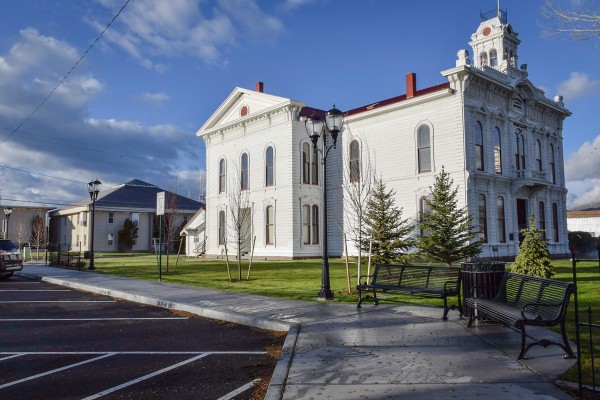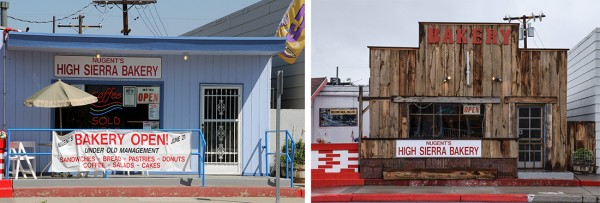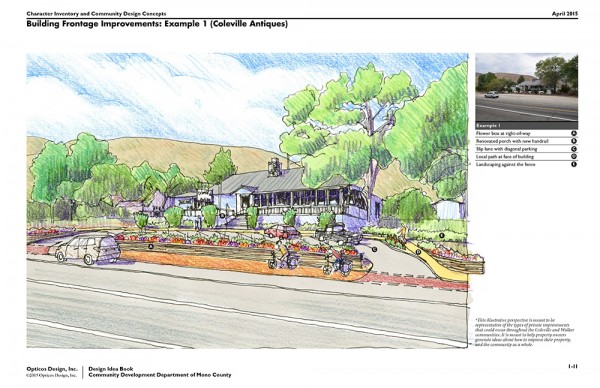U.S. Highway 395 (shown above), otherwise known as the Three Flags Highway, is the only road not part of the interstate highway system that extends from the Canadian border to southern California, through some of the most scenic and remote parts of the Western United States.
The project included a road diet that re-envisioned Main Street through a dynamic public process, with only nine weeks for implementation. Main Street now features new bike lanes and more street parking to support adjacent businesses thanks to angled back-in parking, which replaced simple parallel parking. School Street Plaza is the result of a County-led effort to construct a new pedestrian plaza and parking area adjacent to Bridgeport’s historic courthouse.

“The beautification project at the courthouse is superb,” said Lynda Pemberton, owner of the Jolly Kone restaurant in Bridgeport. “Foot traffic has picked up in town because of the new back-in parking, so I think it was a positive thing.”
The Design Idea Book also makes suggestions for private property owners to improve their frontages with façade renovations and better signage. The goal is to establish a flexible palette of design techniques and approaches that can assist with building renovations and new construction projects, and ensure a positive contribution to the community’s character. In the 18 months since the document’s adoption, several projects have been completed with positive results.
The High Street Bakery was one of the first businesses to complete a low-cost façade upgrade following Design Idea Book guidelines. “The bakery was originally built by my grandparents in 1952 and it had never been updated since then,” said owner Steve Nugent.
The bakery had an unremarkable 20-foot storefront sandwiched between Jolly Kone and the Eastern Sierra Community Bank. Nugent says the bakery’s new western-inspired storefront attracts foot traffic and adds to the community’s sense of place—the old ghost town of Bodie is a California state park and local landmark.

Additionally, he says, the planning process has brought residents together. “It’s instilled in us more of a sense of community involvement in improving our businesses and the look of Main Street.”
To capitalize on the highway as a whole and its many unique places, Mono County officials and community members have joined together to apply for a National Scenic Byway designation, which requires a road to have archeological, cultural, historic, natural, recreational, or scenic significance. To support that application, Opticos more recently led an effort to create design recommendations for public and private realm improvements in several communities along Highway 395.
Mono County communities feature a range of subtly distinct characteristics. North Mono County, including Coleville, Walker, and Bridgeport, evokes a traditional western character, while the character of South Mono County, from Lee Vining to June Lake, Mammoth Lakes, Crowley Lake, and Long Valley, revolves around local and world-renowned ski resorts. Though the existing character of each community is evident, there are many locations where the relationship between Highway 395 and its context could be improved.
The Mono County Design Idea Book offers strategies for maintaining and enhancing the county’s intrinsic qualities and how new development might be accommodated while still preserving the character of the corridor.
Public realm improvements include recommendations for signage and wayfinding, which demonstrate how well-built and well-placed signs can better support the visitor experience. Gateway signs, bike paths, and sidewalks all encourage drivers to slow down naturally—improving comfort for non-vehicular users can increase pedestrian and bicycle activity, thereby increasing business activity. Highway 395 is already an important route for bicycle touring along the shoulder, however bicycle traffic could increase with a formal bike lane to improve safety and ease of use.

“Mono County is thinking about rural planning and revitalization in a different and progressive way,” said Opticos Principal Stefan Pellegrini. “Rather than imposing strict standards and aiming for pie-in-the sky capital improvement projects, the County is working closely with community members and stakeholders, providing them with resources and helping them to facilitate their own improvements that work toward a common good. So far, the results have been outstanding.”
The process for creating the Design Idea Book for Mono County was similar to that of Bridgeport. The design team began with a series of workshops, meeting with business owners, interested community members, and agency representatives to discuss opportunities and community challenges. The team completed a walking audit and there was also time to get feedback and guidance from community stakeholders.
“It was a very smooth process, I liked it. It showed a lot of different ideas. I thought it was positive,” said Erinn Wells of the Bridgeport charrette process. Wells owns the Walker River Lodge, Silver Maple Inn, and the Cain House. “There’s still a ways to go, but more businesses will complete upgrades this year. I think it really has made a difference to make Bridgeport look like a small, cute town.”
The two design book projects reinforce the extent to which Mono County citizens are interested in improving their communities. “This is actually a very unique approach, which will ultimately get Mono County a lot of recognition,” said Pellegrini.